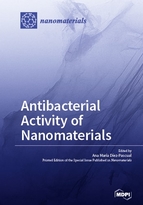Antibacterial Activity of Nanomaterials
A special issue of Nanomaterials (ISSN 2079-4991).
Deadline for manuscript submissions: closed (28 February 2018) | Viewed by 150354
Special Issue Editor
Interests: nanomaterials; polymers; nanocomposites; inorganic nanoparticles; antibacterial agents; surfactants; interphases
Special Issues, Collections and Topics in MDPI journals
Special Issue Information
Dear Colleagues,
Bacterial adhesion and proliferation is a serious and increasing concern in everyday life, and is responsible for significant damage in several industries, including textile, water treatment, marine transport, medicine and food packaging. Notwithstanding the enormous efforts by academic researchers and industry, a general solution for restricting bacterial colonization has not been found yet. Therefore, new strategies for controlling bacteria activity are urgently needed and nanomaterials constitute a very promising approach. This Special Issue plans to give an overview of the most recent advances in the field of antibacterial nanomaterials and their applications in diverse areas. The Special Issue is aimed at providing selected contributions on advances in the synthesis, characterization, and applications of nanomaterials with antibacterial activity.
Potential topics include, but are not limited to:
• Antimicrobial nanoparticles
• Antibacterial nanocoatings and nanocomposites
• Mechanisms of action
• Antimicrobial food packaging
• Adverse effects of nanomaterials
• Future perspectives for antimicrobial nanomaterials
• Role of antimicrobial nanomaterials in medicine
Guest Editor
Manuscript Submission Information
Manuscripts should be submitted online at www.mdpi.com by registering and logging in to this website. Once you are registered, click here to go to the submission form. Manuscripts can be submitted until the deadline. All submissions that pass pre-check are peer-reviewed. Accepted papers will be published continuously in the journal (as soon as accepted) and will be listed together on the special issue website. Research articles, review articles as well as short communications are invited. For planned papers, a title and short abstract (about 100 words) can be sent to the Editorial Office for announcement on this website.
Submitted manuscripts should not have been published previously, nor be under consideration for publication elsewhere (except conference proceedings papers). All manuscripts are thoroughly refereed through a single-blind peer-review process. A guide for authors and other relevant information for submission of manuscripts is available on the Instructions for Authors page. Nanomaterials is an international peer-reviewed open access semimonthly journal published by MDPI.
Please visit the Instructions for Authors page before submitting a manuscript. The Article Processing Charge (APC) for publication in this open access journal is 2900 CHF (Swiss Francs). Submitted papers should be well formatted and use good English. Authors may use MDPI's English editing service prior to publication or during author revisions.
Keywords
- Antibacterial activity
- Nanocomposites
- Bacterial infection
- Nanotoxicology
- Antibiotic resistance







